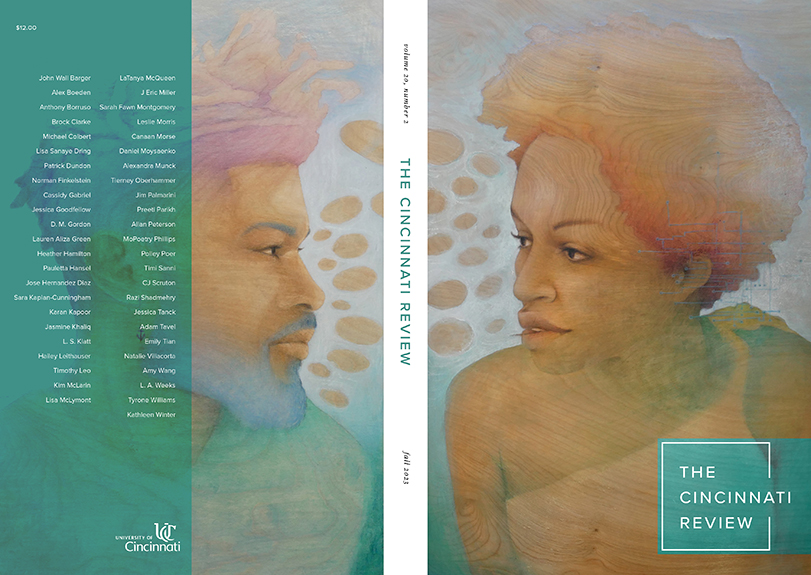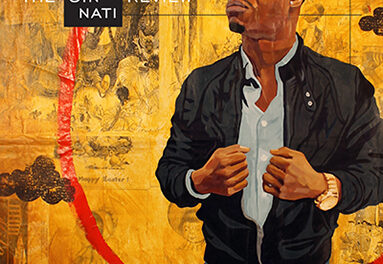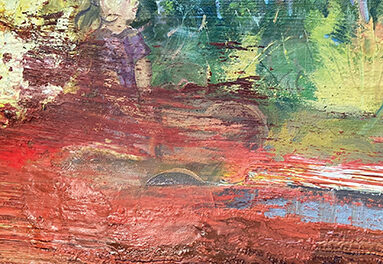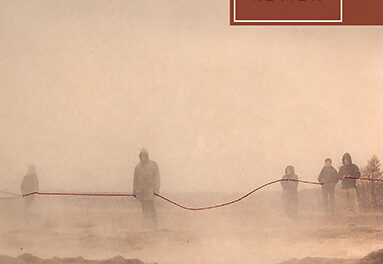In Issue 20.2, one of our twentieth-anniversary issues, we present a special feature on where writing lives in Cincinnati. We reached out to six writers who are current or former residents of the city, giving them the following prompt:
We’ve been thinking about Cincinnati as the site of intersections: of North and South, with the subversive crossing between them by the Underground Railroad; of the geography shaped by an advancing and then retreating glacier, the Ohio River, and the hills; of the Indigenous Algonquian speaking tribes, including the Delaware, Miami, and Shawnee tribes, whose land was taken by white settlers as it became known as Losantiville in 1888. We’re interested, also, in thinking about how the diverse strands of our literary community intersect (or not) here in Cincinnati. Though our various groups focused on creative writing have sometimes felt like separate silos, the Cincinnati Poet Laureate position, the Cincinnati and Hamilton County Public Library writer-in-residence program, and other initiatives like it are breaking down those divisions at times. What is the story of Cincinnati and its literature(s), from your point of view? Where does writing “live” here?
We’re pleased to share here Natalie Villacorta’s contribution to the conversation. (Read the entire feature here.)
Recently a friend invited my husband and me to meet someone thinking about moving to Cincinnati. “These are the people I was telling you about who love Cincinnati,” my friend said by way of introducing us. My husband and I have developed a reputation in the University of Cincinnati’s creative writing PhD program for being East Coast transplants who love the area. How did it happen that we love this city so much, likely more than many of our classmates, most of whom moved away after the third year in our program and finished remotely?
I credit our love partially to WordPlay Cincy, a nonprofit focused on helping children find and express their voices through storytelling in many forms: writing, performance, and visual art. I started teaching workshops at WordPlay shortly after moving to Cincinnati because I was looking for a way to take creative writing outside of the college classroom, to work with young people who historically don’t have access to such programs. Having taught before, I expected to find the teaching rewarding, but what I didn’t expect was how being a teaching artist for WordPlay—through the practices I developed in my teaching, the neighborhoods it took me to, and the people I met—would help me with my own writing and contribute to making Cincinnati not just a place where I lived but also a place I felt connected to.
When I started my PhD at UC in the fall of 2018, I was hugely intimidated by my peers and professors. Though I had written only a handful of short stories (my MFA was in creative nonfiction), I was taking a novel-writing workshop with people who had published fiction in esteemed literary magazines and had completed full novel manuscripts. I could not help but compare myself to these peers and feel that I didn’t deserve to be there. My self-doubt made it hard to write. I was up for workshop just once the first semester and only a few times in subsequent semesters, so the stakes felt incredibly high. When it came time to share my work, my heartbeat raced. I kept my arms close to my sides to hide my boggy armpits. As the rest of the class discussed my work, all I could hear was what was wrong with my writing, that I was a bad writer.
The writing environment at WordPlay was a welcome alternative. I started out as a volunteer, assisting a teaching artist named Jenny who was an English teacher at Mason High School; she taught a class called “My Story, My Voice” for nine-to-twelve-year-olds. Every Saturday morning, exhausted from the week, sometimes having been out drinking the night before, a small part of me wanted to stay in bed and keep sleeping. But the desire to participate in Jenny’s class was stronger, and I would scramble out of bed, throw on some clothes, and race over to WordPlay’s Northside headquarters. Each week, we read a poem or short story in which the writer thought through some aspect of their identity: “My First Memory (of Librarians)” by Nikki Giovanni, “Shootaround” by Jacob Saenz, “Eleven” by Sandra Cisneros. Then we wrote a piece inspired by that work, and those who were willing shared their writing. Afterward, the group offered “Golden Lines”—words or phrases that struck us as particularly strong. It felt good to write to prompts, to write in a low-stakes way. It felt good to write something and immediately share it and get feedback—even if it was from a bunch of kids. I was inspired by the students, how they started writing without hesitation, how they often were keen to share, unhampered by self-doubt. Writing didn’t always have to be hard and self-esteem shattering; it could also be fun and uplifting.
The next fall, a few months after I moved to the Northside neighborhood myself, I took over the class for Jenny. After the poet Ross Gay came to town for the University of Cincinnati’s reading series, I taught the title poem in Catalog of Unabashed Gratitude (University of Pittsburgh Press, 2015) to my WordPlay students. We read the poem aloud and then noticed what Gay notices: A barefoot baby tamping down the soil over a newly planted apple tree in a community orchard. The “flocking / of men” who help an old lady “falling down / on the corner of Fairmount and 18th.” The barefoot woman who stops her car in the middle of the road to rescue a crossing turtle. Not flowers, but hyacinth and crocuses and zinnias and false indigo. Then, clipboards in hand, we went for a walk, heading down Hamilton Avenue, looking for things that filled us with gratitude. Toby noticed the fluffy white clouds, Owen noticed how sad Hoffner Park looked when the farmers market wasn’t on, and Salaam noticed a Michael Jackson T-shirt on the wall of Shake It Records: MJ in a tux, leaning back against a brick wall: the Off the Wall album cover art.
I noticed a brick house with a peach tree in the front yard, branches stretching out over the chain-link fence, dipping down to the sidewalk. A woman with curly red hair was sweeping the front porch. When I asked if it was okay for us to admire her garden, she offered us some peaches. She brought a wooden bushel basket to the sidewalk, and at first I balked—Don’t take food from strangers!—but I realized this woman wasn’t a stranger, she was a neighbor, and we all reached in. The peaches were small and yellow but blushing red. “What do they smell like?” I asked the kids.
“Sweet!” they said.
“How do they feel?”
“Furry!” “Fuzzy!” Little lint balls on their skin.
I thought, Ross Gay would love this shit. I don’t know if I’d read it at the time, but in “To the Fig Tree on 9th and Christian,” Gay describes a similar experience, except with a fig tree in Philadelphia.
“What’s your name?” I called out to the peach lady.
“Ginger!” she said. Of course, I thought, she was a redhead! Ginger asked mine, and I told her, and the kids and I headed back, noticing still other things: blue splatter on a brick wall and sidewalk (“It looks like someone threw blueberries!”), how the air outside the pizza place smelled like burnt bread. Back at our desks, we wrote our own catalogs of gratitude and shared them. I left the class feeling so joyful: “It is good to stop and look and say thank you. . . . Today WordPlay was delightful because I want to see kids excited, engaged,” I wrote in my journal.
I took this noticing exercise beyond the class, making a practice of noticing every time I left my house for a walk—which I did increasingly during the pandemic—and I found so much to love about my neighborhood and Cincinnati at large. Outside a house on Cherry Street, there was a basket of snacks for delivery workers—chips and Chewy bars and sleeves of nuts. On the steps to the Northside public library, beside a water bowl for dogs, a sign: “Take a stick, leave a stick” and a pile of sticks. Spray-painted on the sidewalk in front of a house on Bruce Avenue: a red circle and the words DANCE SPOT. I danced. On one of these walks, I got the idea to write a story that took place over the course of a walk; the story poured out of me, and later, after many revisions, I published it.
Noticing gave me so much joy that I wanted to share this superpower with others. The next time I held a “Noticing Northside” workshop at WordPlay, I made copies of my students’ catalogs of gratitude, slipped them into plastic sleeves, and tacked them to telephone poles around Northside, hoping that others would be inspired and start their own noticing practices. “Wonder is always around. Just waiting to be found. So next time you’re around / Just listen for sounds and you’ll find something new,” wrote Desi, age eleven. “i wonder wats in this tiny berry so i will put it the grass so it will grow more tiny berrys,” wrote Nellie, age eight.
While my work for WordPlay helped me to see and appreciate my neighborhood, it also helped me to see and appreciate other parts of the city. In the spring of 2020, a woman named Clarity who worked for the Cincinnati Public Library volunteered with my class. When people started protesting police brutality a few months later—after the killings of George Floyd and Breonna Taylor—thanks to Clarity’s Facebook posts, I was informed about where the protests were happening, what bail funds I could donate to for protesters who had been arrested, and the city’s history of police violence. When I saw Clarity at protests, I felt a coherence to my life. The same feeling occurred when Zee, whom I first knew through WordPlay, ended up in my creative nonfiction class at UC, and when Jacob, who was in my podcasting and audio storytelling class at UC, ended up volunteering for WordPlay, and when Caroline, a Xavier University student who volunteered at WordPlay, appeared in a class I taught at Xavier. WordPlay brought together writers from different corners of the city who might not otherwise have connected.
As much as I loved teaching in my own neighborhood (and as much as it was convenient), I knew what I really wanted to do was get outside my community, go into the Cincinnati Public Schools to bring creative writing to kids who couldn’t get to WordPlay or kids who didn’t yet know they liked creative writing. In the spring of 2021, I signed up to teach high school freshmen at Oyler School in Price Hill, or “the P,” as my students called it. My plan was to have my students write personal stories in the style of The Moth and perform their stories for an audience of peers and teachers. I’d done a similar workshop at WordPlay’s headquarters, and it had gone well.
But my Oyler class did not start as smoothly. The students didn’t have much to say about the sample stories I showed them. When we turned to writing and I handed out the prompts (Tell a story about a time you did something you never thought you’d do; a time your relationship with someone you love changed; a time that you took a risk—or decided NOT to take the risk), many of them hardly wrote a word. They said they had no ideas. What was going on?
I was used to teaching affluent white kids who were eager to write and to share their work with each other. But the Oyler students were largely Black and Latinx, working-class and poor. Their experiences as people of color had made them reluctant to write and share their stories. As Felicia Rose Chavez writes in The Anti-Racist Writing Workshop: How to Decolonize the Creative Classroom (Haymarket Books, 2021), “When people of color receive an invitation to write, to exercise voice in public space, naturally we’re wary. Our lives are an exercise in repression—the everyday denial of voice—so as to safeguard our bodies.”
I realized I had to change my plan. Instead of asking students to start writing right away, I first talked through ideas with them. I found that they did have plenty of stories, but they didn’t think theirs were experiences worth telling. Who cared that they had once gotten into a fight at Washington Park? Who cared that their grandma had died? Who cared that their mother was sick? I cared! Once I assured them these were great ideas, they started talking, and it was hard to get them to stop.
But when I asked them to write the stories down, they dragged their feet. The phones came out. I decided to throw out the writing part. Instead of workshopping written pieces, we workshopped oral performances. They balked at performing for an audience of their peers and recording these performances. Some explained they were afraid they would get in trouble. I lowered the stakes: We would just tell them to each other and a select staff person or two. No cameras, no mics, if they didn’t want them. And they could sit down if they preferred.
When, after weeks of coaxing and Domino’s and making a fool of myself dancing to Cardi B, they finally opened up and shared their stories—about being bullied by an older girl, about their best friend moving away, about losing their grandma who raised them, about getting into fights with other girls and getting kicked out of school—I was deeply moved. I realized later that I saw myself in these students: a lack of confidence, a fear that my story wasn’t important or worth telling. I realized that these issues were getting in the way of important stories being told, and that I was in a position to help students gain confidence and affirm the value of their stories. This is the special role of organizations like WordPlay: You can learn the techniques and craft of creative writing in many places, but if you do not believe that you are capable and that people want to hear your story, that your story deserves to be told and has power, these skills don’t matter. WordPlay enables kids (and adults) to find joy in writing, to build confidence, and to find community—all of which are essential to the creation of literature but which writers at higher levels and in academia can sometimes forget.
Natalie Villacorta is a writer from McLean, Virginia. Her fiction and creative nonfiction have been published in Joyland, Hobart, The Offing, DIAGRAM, and Moss. She is an assistant professor of English and creative writing and the director of the Center for Speaking and Writing at Agnes Scott College in Decatur, Georgia.











